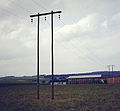Portal mast
A portal mast is an overhead line mast in which the trusses with the conductor cables rest on at least two supports. Portal masts can be designed as a wooden mast , concrete mast , tubular steel mast or lattice mast . In Germany, because of their larger space requirements, they are usually only used for guy masts that have to withstand high tensile forces and as support points for cables in switchgears ( guy gantries ). An exception was a 110 kV line from the Hirschfelde power plant via Bautzen to Dresden, which was built around 1924 and which was laid on portal masts throughout.
Portal masts usually have two supporting structures. But there are also masts with three or more load-bearing structures, such as the Zaporizhia mast triple . In the electrification of railway lines, especially when spanning a large number of tracks, the use of portal masts is common around the world, as they have better vibration behavior than transverse structures made of cables at high travel speeds. In Germany, on the other hand, transverse structures are not replaced by portal masts, but by single masts.
In 2015, a storm knocked over 14 Danube masts on a 380 kV overhead line from 50Hertz near Erdeborn . Instead of the old Danube masts, temporary portal masts were erected.
gallery
500 kV cable-braced portals in Northern California
Railways

Portal masts are common for overhead lines of multi-track electric railways.







